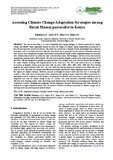| dc.description.abstract | The
aim of this study is to assess adaptation and coping strategies of Maasai pastoralist to climate
change and identify viable adaptation options to reduce the impac
t of climate change among Maasai pastoralist in
the arid and semi
-arid (ASALS) in Kenya. The study was carried out in Kajiado County and multiple data collection
techniques such as in-
depth interview with 305 households, focus group discussion, and key inf
ormant interview
were used to assess adaptation strategies of pastoralist household and identify viable adaptation options for the study
area. Rainfall data used for the study was also collected from Kenya Meteorological Service (KMS) and used for
standard
precipitation index (SPI) analysis.
SPI
was used to analyze drought severity in the study area between 1970
and 2013. SPI was designed to quantify precipitation deficit for multiple time scale
. Results showed that drought is
the major climatic challenge affecting pastoralist in the study area. The SPI result showed increase in drought
occurrence in Kajiado County in recent years with six years (2000, 2003, 2004, 2007, 2008 and 2011) having
negative SPI values between 2000
-2011. The year 2000 was also the driest year recorded in the study with an SPI
value of -
3.09. The study also showed that Maasai pastoralists already have many adaptation measures to cope with
the impacts of climate extremes. However, increase in drought occurrence in the last few years is
reducing their
resilience. This study observed that most of the adaptation and coping strategies adopted by Maasai pastoralist are
autonomous and are unlikely to build resilience of pastoralist livelihoods
and ecosystems
to cope with the projected
magnitude and scale of climate change in the 21
st
Century. The study identified adaptation strategies such as
effective early warning system,
water harvesting, rapid infrastructural development, encouraging table banking and
cooperative societies, Building and equipping schools, migration, livestock diversification and child education as
long term no regret adaptation option that can enhance res
ilience of Maasai pastoralist to climate change and its
extremes in the arid and semi arid lands of Kenya. | en_US |



